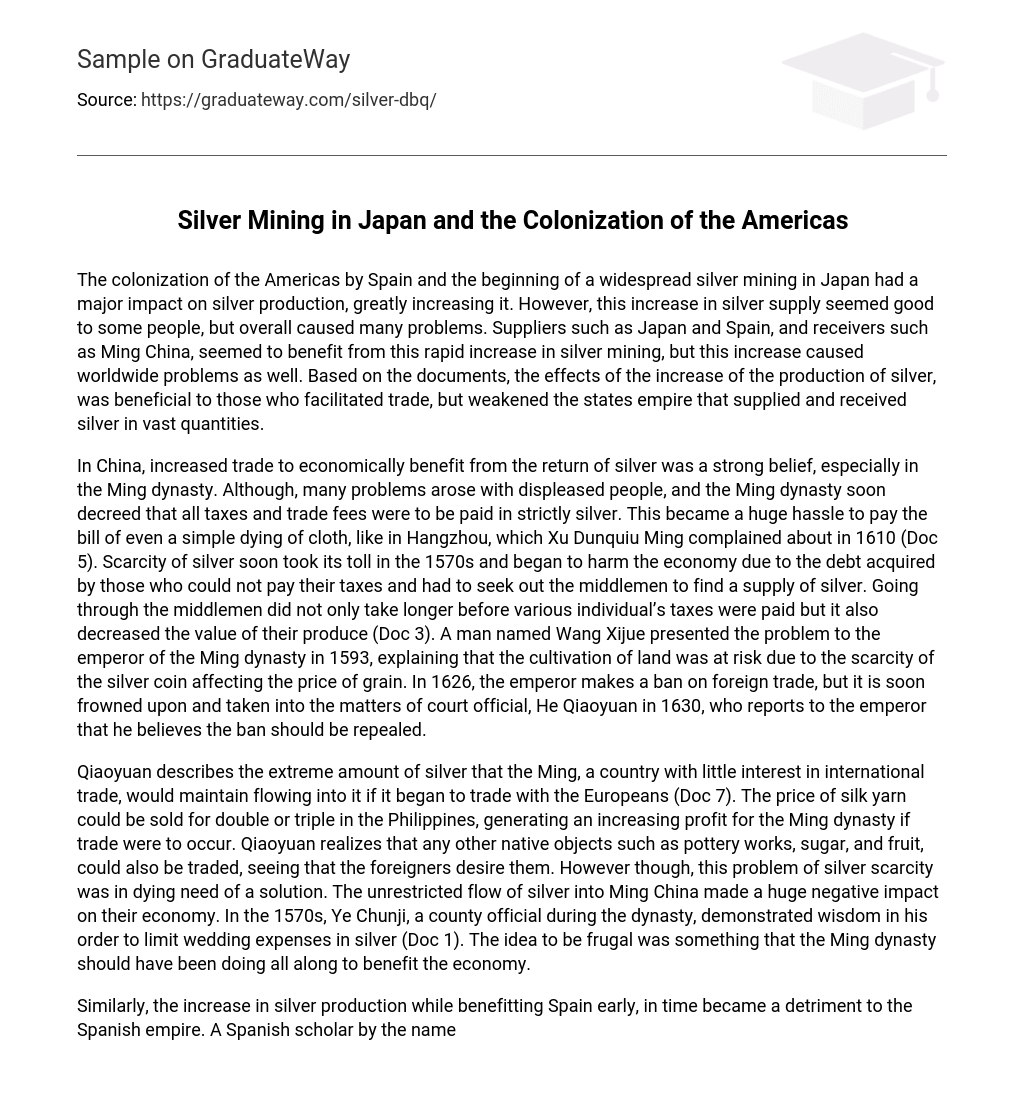The colonization of the Americas by Spain and the start of extensive silver mining in Japan greatly boosted silver production, which had both positive and negative consequences. Japan and Spain, as suppliers, along with Ming China, as a receiver, appeared to benefit from the surge in silver mining. However, this increase also resulted in global problems. According to the documents, the expansion of silver production conferred advantages to those involved in trade but weakened the empire responsible for supplying and receiving large quantities of silver.
Increased trade in China during the Ming dynasty was focused on benefiting economically from the return of silver. However, this led to several problems. In response, the Ming dynasty decreed that all taxes and trade fees must be paid in silver, causing difficulties for simple transactions like dying cloth in Hangzhou. Xu Dunquiu Ming complained about this in 1610 (Doc 5). The scarcity of silver started to have a negative impact on the economy in the 1570s as people who couldn’t pay their taxes had to seek middlemen to obtain silver, resulting in debt. This not only delayed tax payments but also reduced the value of their produce (Doc 3). In 1593, Wang Xijue brought this issue to the emperor’s attention, highlighting its impact on land cultivation and grain prices. As a response, the emperor imposed a ban on foreign trade in 1626. However, this ban was criticized by court official He Qiaoyuan in 1630, who recommended its repeal.
Qiaoyuan, in Doc 7, discusses the significant influx of silver that would occur if Ming China traded with Europeans, despite the country’s lack of interest in international trade. If trade were to happen, the Ming dynasty could generate substantial profit by selling silk yarn for double or triple its price in the Philippines. Qiaoyuan also recognizes that other native goods such as pottery works, sugar, and fruit could be traded as well, as foreigners desire them. However, the problem of silver scarcity urgently needs a solution. The unrestricted flow of silver into Ming China has severely impacted their economy. In the 1570s, Ye Chunji, a county official, demonstrated wisdom by imposing limits on wedding expenses in silver (Doc 1). The Ming dynasty should have practiced frugality all along to benefit the economy.
The escalation of silver production not only initially benefited Spain, but eventually became a disadvantage to the Spanish empire. In 1571, a Spanish scholar named Tomas de Mercado of Seville revealed that the high prices attracted Asian commodities which resulted in the ruin of Spain, as the silver currency had to be poured out to pay for them (Doc 2). Likewise, Antonio Vazquez de Espinosa, a Spanish priest, pointed out in the 1620s that he noticed a more negative aspect of silver production in terms of its social impact (Doc 6). He expressed his sympathy for the over 3,000 Indians who labored at Potosi, a massive silver mine in Spain, to extract the precious metal for trade and taxation purposes.
According to British merchant Ralph Fitch in 1599, the increase in silver production benefitted middlemen more than producers and consumers. The Portuguese, for example, carried various luxury goods such as white silk, gold, perfume, and porcelain to Japan, but only brought back silver. They profited greatly from this trade and used the silver to buy more luxury goods from China, which they could then trade again for a profit in Japan. This made them the profitable intermediaries (Doc 4). Similarly, in 1697, English scholar Charles D’Avenant wrote an essay on the East-India trade, discussing the debate on a bill to restrict Indian textiles. He noted that all aspects of this trade revolve around middlemen due to the high demand for luxury goods from Asia in Europe.
The global flow of silver had wide-ranging effects on different regions. It had both positive and negative impacts. The increase in silver production in Japan and the Spanish empire during the 16th to 18th centuries benefited various parties, including consumers, suppliers, and intermediaries. However, the flow of silver did not benefit Ming China and led to economic issues. To gain further understanding, it would be helpful to have a document from a Chinese merchant detailing how trade was conducted. Additionally, documents discussing the effects of silver mining on Japan would provide valuable insights into the production dynamics between Japan and Spain.





